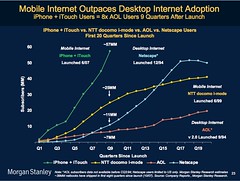My thoughts on the new 27" iMac after 3 days use

I've had my iMac for 3 days now so I thought I'd write about a few observations I've made. I previously wrote about the high calibre of the new display within the 27" iMac. After now using this display, I can attest that it is indeed a thing of beauty. Watching hi-res videos, whether from iTunes or Youtube, it looks great. The color gamut is awesome. The viewing angle is awesome, and I'm really enjoying using it with my new Bamboo Fun.

Speed
As for the speed question? It's fast. Application resource hogs that used to take many 'bounces' to open on the Dock now open in 2 or 3 bounces at most. Adobe Lightroom 3 Beta now opens in less than 6 seconds. I was able to import 400 RAW photos from my Canon 40D to Lightroom while also importing 30 minutes worth of video from my new Flip Ultra to iMovie at the same time the iMac handled the workload just fine.
Bluetooth connection issues with the Apple Wireless Keyboard & Magic Mouse
My major problem has been, so far, having the Apple Wireless Keyboard & Magic Mouse lose their bluetooth connection. I don't mind typing on this keyboard, although I dislike the fact that Apple felt the need to chop off the number pad. The Magic Mouse is leaps and bounds improved over the previous Mighty Mouse, but that being said, it still is not comfortable to use for any length of time if you hands are as large as mine. It feels tiny in my hand. Too small, too uncomfortable. Sure, it's beautifully designed but my 
 Logitech G5 just feels NICE is my hand. Oh and it has a wire so if the CPU spikes to 100% for 3 hours when encoding video, the damned thing doesn't lose connection.
Logitech G5 just feels NICE is my hand. Oh and it has a wire so if the CPU spikes to 100% for 3 hours when encoding video, the damned thing doesn't lose connection.
And while I'm on that topic....the keyboard & mouse only seem to lose connection whenever the CPU cores max out to 100% for any length of time (mostly video encoding so far). HA! As I type this post, and watch MacBreak Weekly on youtube in HD, the damned keyboard lost its connection again. iStat Menus reports my current CPU use at ~ 55% on both cores.
Really Apple? How do you expect people to use this thing? It wouldn't be quite as bad if it automatically reconnected on its own. Sadly, that is not the case. Even keying the bluetooth drop-down menu, selecting disconnect for the keyboard, and then selecting connect again will not cause it to reconnect. I have to toggle bluetooth off and then toggle it back on in order for it to pick up the keyboard once more. This process is sufficiently annoying and tedious to make this product unusable for me. Thanks to Amazon Prime, I should have the wired full-sized keyboard by
Luxurious desktop screen real-estate
Did I mention how BIG this screen us? Under my previous desktop setup I was using a 17" MacBook Pro alongside a Dell 24" Widescreen LCD. I'm still at my family's farm in southern Virginia, so alas, haven't hooked the Dell up to the iMac yet. Under the previous setup, I used the MacBook's screen on the left to keep things like GMail, Adium, and Twitter displayed all the time. I use the 24" Dell as my main screen. Under this setup, I plan to use the 27" iMac as the main screen with the Dell as the secondary display for panels such as Twitter/email/IM. Even without the second display, I'm able to comfortably have a full sized Chrome window alongside my MarEdit markup screen + its preview screen. Also, I have Adium & Tweetie for Mac tucked up in the top right corner. All at once. On one screen. Without using Spaces. AWESOME.Editing photos of the family I took during Christmas was a treat within Lightroom as well. None of the various control panels felt cramped on the screen as I was still able to see a fairly large image in the center for editing. I high recommend this computer to photographers or designers who regularly use Adobe products.
Now, a reminder, I've only used this machine for 3 days, so my experience is limited but overall I have found no faults with the iMac. Apple's peripherals on the other hand...















